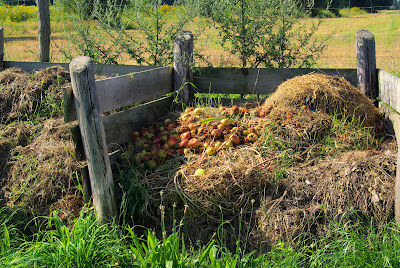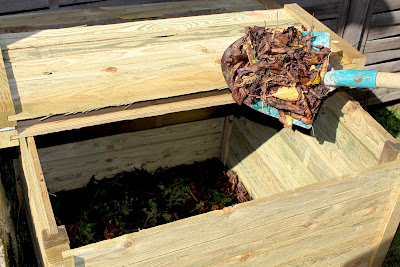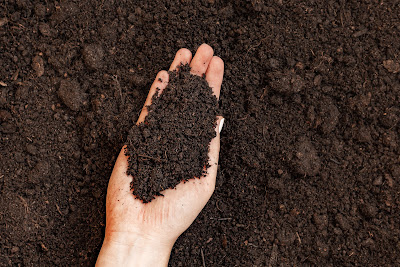Where do your food wastes go after you dump them? In Europe, half of them go to landfill(24%) and get burned (27%), 31% are recycled and 17% are composted (EUROSTAT)
After food wastes go to landfill, even though they are biodegradable, they are compacted underground decomposing without oxygen. This process produces methane, a greenhouse gas 84 times more harmful than CO2. So, I won't lie to myself that food scraps will decompose organically or harmlessly after I dump them.
Food wastes also take up a lot of spaces in landfill. In the EU, each person generates 173kg of food waste per year, which amounts to about 88 millions tonnes of food wastes. Estimated in 2010, Netherland ranked top of the generation of food wastes kg per person (541kg). Belgium comes in second (345kg). The UK is also high (236kg). In France where people have love for food, they generate below average, but still 136kg per person per year.
Food wastes are generated from primary production, wholesale, retailing, processing, catering and household cooking. Surprisingly, household produces 53% of food wastes, more than any commercial procedures, so each person makes 92kg food wastes per year when they buy groceries, cook and eat. That sounds just like what's happening everyday in my house.
We have little to do with the food waste on those commercial levels, including production, processing and wholesale level. However, in your house, you have choices everyday when you shop, cook and eat. You pay for food, why waste them?
You can make choices to control or reduce that 53% of food wastes happening in your home ! By following these three simple tips :
1. Know the difference between the labels "Best Before" and "Use by":
Best Before: the date after which an item may still be eaten but may not be at best in terms of quality. Normally, I would still eat it 3 days within the "Best Before" day.
Use by: after which an item is no longer safe to eat.
2. Cook and eat your food scraps
Save money, save the earth. Check out recipes for food scraps. You can marinate broccoli stems, a great source of fiber. You can sauté beet greens with lemon butter or make vegetable stock from carrot, asparagus skins and corn cob. Nobody will know they used to be food scraps!
3. If your food scraps can't be cooked anymore, compost them
Food scraps in general contains the right carbon to nitrogen ratio(20:1), close to the perfect C/N ratio for composting (30:1). They also have been chopped into small pieces so no extra work for composting if you use iComposteur. iComposteur composts your daily food scraps up to 2 kg and the compost will be ready in 2 weeks risk-free.
If you want to start a classic composting pile to compost your food scraps, the steps are:
1). Store your food scraps for at least 2 weeks. In refrigerator or any cool place. In summer, be careful about cockroaches.
2). Scavenge fallen leaves, sawdust, branches, cardboard, grass clippings and hay etc, making sure altogether you have enough ingredients for construction of a 1m*1m*1m pile.

|
| Grass Clipping, sawdust, branches, fallen leaves even wood chips are sources of compost |
3). Classify them into Greens(Nitrogen) and Browns(Carbon) by using this table:
Example:
For 180 gram of corn stalk, there are about 177g carbon and 3g nitrogen (60:1). While for 180 gram of chicken manure , there are about 162g carbon and 18g nitrogen(10:1). So chicken manure is a bigger source of nitrogen than corn stalk.
| Carbon Rich Ingredients | CN Ratio | Nitrogen Rich Ingredients | CN Ratio |
|---|---|---|---|
| Corn Stalks | 60:1 | Chicken Manure | 10:1 |
| Corrugated Cardboard | 600:1 | Coffee Grounds | 20:1 |
| Dry Leaves | 40-80:1 | Garden Plants and Weeds | 20-35:1 |
| Mixed Paper Products | 200-800:1 | Grass Clippings | 10-25:1 |
| Newspaper | 150-200:1 | Hay | 10-25:1 |
| Pine Needles | 60-100:1 | Kitchen Scraps(No Dairy, meat, fish) | 10-50:1 |
| Sawdusts, weathered 3 yrs | 142:1 | Rotted Manure | 20-50:1 |
| Sawdusts, weathered 2 months | 625:1 | ||
| Straw | 50-150:1 | ||
| Woody Plants trimmings | 200-1300:1 |
Carbon to Nitrogen Ratios Source: Composting for Dummies P. 108 , 2010, Wiley
4). Chop everything into small pieces, especially branches, twigs and cardboards.
5). Mix them with the Carbon to Nitrogen ratio 3:1 by volume or 30:1 by weight.











0 Comments